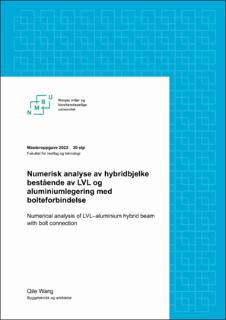| dc.contributor.advisor | Themistoklis Tsalkatidis | |
| dc.contributor.author | Wang, Qile | |
| dc.date.accessioned | 2023-07-08T16:27:15Z | |
| dc.date.available | 2023-07-08T16:27:15Z | |
| dc.date.issued | 2023 | |
| dc.identifier | no.nmbu:wiseflow:6780174:53392147 | |
| dc.identifier.uri | https://hdl.handle.net/11250/3077301 | |
| dc.description.abstract | Miljøproblemer som globaloppvarming har lenge vært et stort problem. Bærekraftige materialer blir derfor ønsket for å tilpasse strengere klimamål. Hybridelementer er et av de byggevarene som bidrar til å minske klimagassutslipp og samtidig tilbyr de like gode mekaniske egenskaper. Mekanismen til hybridelementene er å kombinere to eller flere materialer og drar nytter fra hvert materiale. Det sørger for at ressursene blir benyttet på en optimal måte. Aluminiumlegering har lav vekt, høy korrosjonsbestandighet og høy styrke i forhold til sin lave vekt. LVL er et trebasert konstruksjonselement med høy bærende evne. Den er miljøvennlig og lett å forme. Hybridbjelken som består av de to materialene, kan derfor være en bærekraftig løsning for fremtiden.
Denne oppgaven analyserer numerisk hvordan endring av stivhet oppstår når tykkelse på deler av hybridbjelken endrer seg. Effekten av bolteforbindelse er også undersøkt. Oppgaven har tatt fokus på tolkning av ultimate nedbøying i midten av hybridbjelken og glidning mellom delene av hybridbjelken. Numerisk analyse er gjort ved hjelpe av tredimensjonale modeller bygd i Ansys Mechanical APDL 2022 R1 som benytter elementmetode. Modellen blir verifisert ved å sammenligne resultater fra en eksperimentell bøyetest. Både elastiske og plastiske materialegenskaper har blitt definert. LVL anses som et ortotropt materiale og aluminiumlegering som et isotropt materiale.
Resultater fra analysene viser at numeriske modeller kan simulere eksperimenter med lite avvik. Nøyaktigheten av modeller kan justeres ved å endre innebygde parametere i Ansys etter behov. En tykkere LVL-bjelke vil bidra til en stivere hybridbjelke, men det øker også glidingen fra aluminiumbjelken. Det gir en stiv forbindelse med 66 bolter og kan forbedres ved å øke boltantallet, men det anbefales ikke å redusere flere bolter. Stivhetsendring er lite signifikant når tykkelse av steget på aluminiumbjelke er forandret og gir derimot større glidning. Generelt har hybridbjelken av LVL og aluminiumlegering har høy stivhet i forhold til sin lave vekt og er korrosjonsbestandige. Den kan være et godt alternativ til tradisjonelle byggematerialer. | |
| dc.description.abstract | Environmental problems such as global warming have long been a major problem. Sustainable materials are therefore desired to adapt to stricter climate targets. Hybrid elements are one of the construction elements that help reduce greenhouse gas emissions and at the same time offer equally good mechanical properties. The mechanism of the hybrid elements is to combine two or more materials and benefits from each material. It ensures that resources are used in an optimal way. Aluminium alloy has low weight, high corrosion resistance and high strength in relation to its low weight. LVL is a wood-based construction element with a high load-bearing capacity. It is environmentally friendly and easy to shape. The hybrid beam, which consists of the two materials, can therefore be a sustainable solution for the future.
This assignment numerically analyzes how changes in stiffness occur when the thickness of parts of the hybrid beam changes. The effect of bolted connection has also been investigated. The assignment has focused on interpretation of ultimate deflection in the middle of the hybrid beam and slip between the parts of the hybrid beam. Numerical analysis is done with the help of three-dimensional models built in Ansys Mechanical APDL 2022 R1 which uses finite element method. The model is verified by comparing results from an experimental bending test. Both elastic and plastic material properties have been defined. LVL is considered an orthotropic material and aluminium alloy an isotropic material.
Results from the analysis show that numerical models can simulate experiments with little deviation. The accuracy of models can be adjusted by changing built-in parameters in Ansys as needed. A thicker LVL beam will contribute to a stiffer hybrid beam, but it also increases the slip from the aluminium beam. It provides a rigid connection with 66 bolts and can be improved by increasing the number of bolts, but reducing more bolts is not recommended. The change in stiffness is not significant when the thickness of the web on the aluminium beam is changed and, on the other hand, results in greater slip. In general, the hybrid beam of LVL and aluminium alloy has high stiffness in relation to its low weight and is corrosion resistant. It can be a good alternative to traditional building materials. | |
| dc.language | nob | |
| dc.publisher | Norwegian University of Life Sciences | |
| dc.title | Numerisk analyse av hybridbjelke bestående av LVL og aluminiumlegering med bolteforbindelse | |
| dc.type | Master thesis | |
